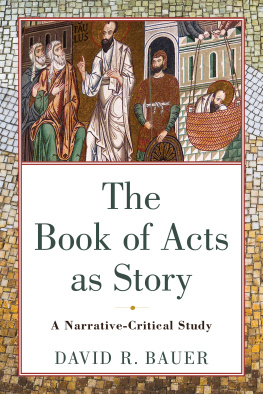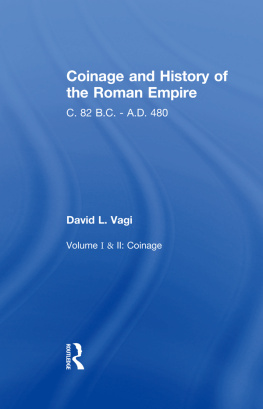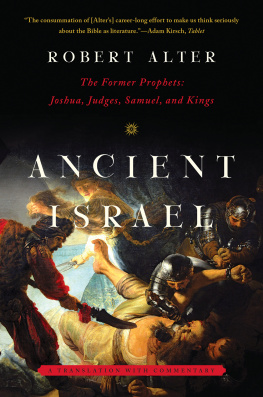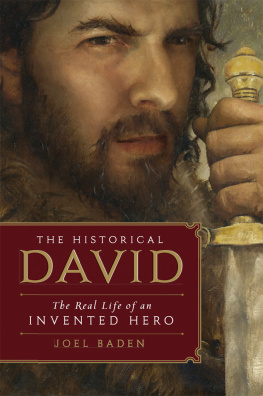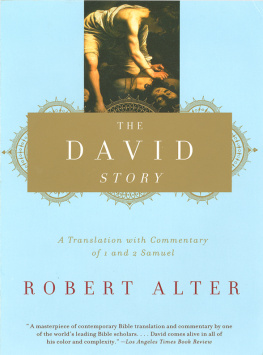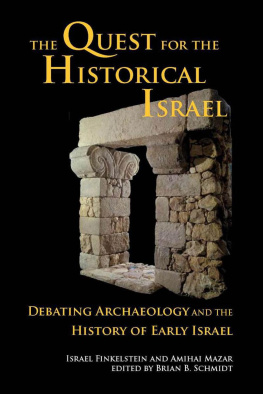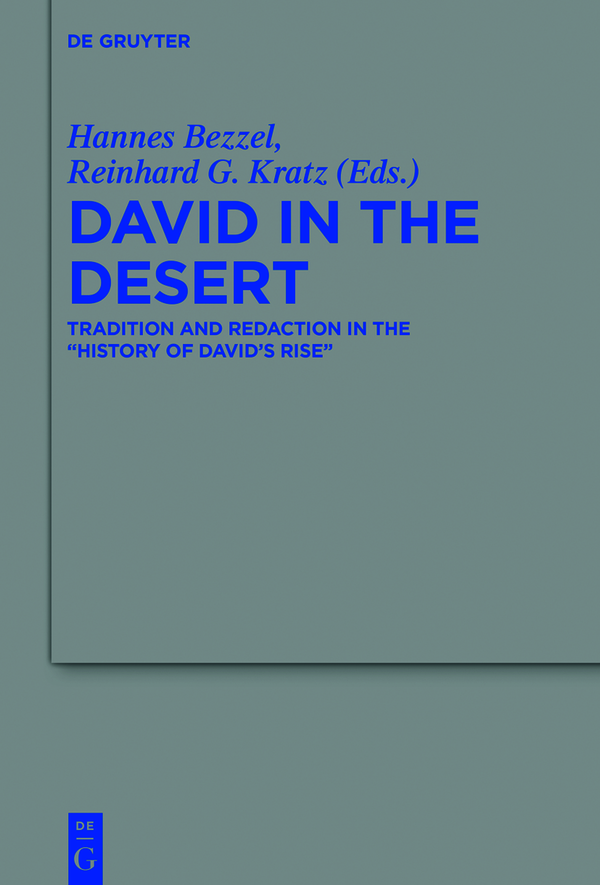Beihefte zur Zeitschrift fr die alttestamentliche Wissenschaft
Edited by
John Barton
Reinhard G. Kratz
Nathan MacDonald
Sara Milstein
Markus Witte
Volume
ISBN 9783110604061
e-ISBN (PDF) 9783110606164
e-ISBN (EPUB) 9783110605273
Set-ISBN 9783110606171
Bibliographic information published by the Deutsche Nationalbibliothek
The Deutsche Nationalbibliothek lists this publication in the Deutsche Nationalbibliografie; detailed bibliographic data are available on the Internet at http://dnb.dnb.de.
2021 Walter de Gruyter GmbH, Berlin/Boston
Introduction
Prof. Dr. Hannes Bezzel
Friedrich-Schiller-Universitt Jena, Jena, Germany
Prof. Dr. Reinhard G. Kratz
Georg-August-Universitt Gttingen, Gttingen, Germany
As in many fields of Old Testament / Hebrew Bible studies, well-known theories about the origin of the Biblical traditions about king David have been questioned in the course of the last two or three decades.
On the one hand, this concerns the historical reconstruction of the socio-political situation in the Levant during the early Iron Age in general and of Davids reign in particular. Concepts of a strongly centralised empire as it is depicted in 2 Sam 8 which were a basic part of the historical narrative of ancient Israel until not so long ago, have been abandoned, questioned or heavily modified because of the archaeological findings.
On the other hand, the familiar redaction-critical hypothesis of an ancient literary source covering the first part of the David story, as it was put classically by Leonhard Rost with his History of Davids Rise
Taken together, these two hypotheses, the historical and the redaction-critical, which, of course, both have not been unchallenged, raise several questions:
If the History of Davids Rise is correctly identified as a secondary literary bridge which was created in order to bring together the characters of and traditions about Saul and David, what does this interpretation mean for the reconstruction of the history of the time in question, viz., the early Iron Age?
More concretely, the question is whether, and if so, where, there is ancient material preserved between 1 Sam 162 Sam 5, and which pieces of the passage in question are to be seen as younger, redactional additions. In short, this is nothing else but the old literary-critical task of separating tradition and redaction but it has to be asked anew under the recent premises.
Generally speaking, the methodological problem is affected of how the historical interpretation of archaeological findings and the redaction-critical analysis of the Biblical texts can or should not interact with each other: Which part can the Biblical text and its reconstructed literary history play in the reconstruction of the history of Israel and in which way can the archaeological findings and their interpretation support or criticise the diachronic analysis of the text? As clear as both approaches are necessarily connected with each other, as clear is the danger of circular argumentation in both cases.
The papers read at the symposium which have been collected in this book, deal with these questions from a redaction-critical as well as from an archaeological point of view. Some colleagues do so by means of drawing broader pictures while others present focused case studies on certain episodes. Taken together, the articles address nearly every chapter between 1 Sam 16 and 2 Sam 1 in detail, and offer several hypotheses for the literary historical reconstruction of the History of Davids Rise and its historical backgrounds.
Peter Porzig starts by addressing the topic from a point of view which one might call early reception history. He asks for the image of David in the Judean Desert, viz. in the (so-called non-biblical) Dead Sea Scrolls. Not surprisingly, the two dominating aspects here are David the musician and David the warrior. Porzig draws a direct line from the former in 11Q5 XXVII,211 to 1 Sam 16:1423, which he identifies as the youngest version of the story about how David got to Sauls court, and from the latter in 1QM XI,15a to late additions highlighting holy war ideology in 1 Sam 17.
Omer Sergi provides an overview over the recent archaeological interpretation of the settlement history in the Early Iron Age, especially around Jerusalem and on the Benjamin Plateau. He concludes that the latter must have been under Jerusalemite domination, and therefore argues against the theory that the traditions about Saul would been of (Northern) Israelite origin. Instead, he regards Jerusalemite scribes as the circles in which traditions both about Saul the Benjaminite and David the Ephratite were handed down. Both kings shared the collective identity Israelite which in the stories about them originally would not yet refer to the polity in the North but to a clan identity. The historical background of the stories between 1 Sam 9 and 2 Sam 5 were to be seen in the 9th century BCE, displaying a geo-political situation before Hazaels campaign around 840.
In this dating he meets with Sara Kipfer . Kipfer, however, puts the focus on the Land of the Philistines in the Southern coastal plain and the Negev. From a literary-critical look at 1 Sam 27 she turns to a landscape critical analysis (66) of the area before returning to the text. Its basic layer in 1 Sam 27:2,3a,512 is understood as a very old tradition which Kipfer interprets historically as reflecting the situation of the 11th and 10th century with a power vacuum (93) in the Negev. The two papers by Sergi and Kipfer illustrate that Davids relations with the Philistines in general and with Achish of Gath in particular belonged to the dominating themes of the discussion during the conference.
Mahri Leonard-Fleckman also deals with 1 Sam 27 and the area which is described in this chapter. However, she is more interested in the social landscape (103) of the Shephelah and what it means to cross over () the boundaries or territory () in this context. She points out that thinking in categories of defined borders between an Israelite and a Philistine territory, as it can be seen for example in 1 Sam 27:1, would not mirror the spatial conceptions of the Early Iron Age. Therefore, she tentatively questions the nearly unanimous dating of 1 Sam 27 to an early literary stage. Nevertheless ancient oral traditions might be preserved in the written story.
Walter Dietrich , then, gives a source-critical summary of more than three decades of his analytical work with the books of Samuel. He advocates a model which one might call in terms of Pentateuchal research a Fragmentenhypothese. Two larger narrative cycles, one dealing with the Rise and Decline of the Saulides (133), the other collecting stories about David the freebooter (137) as well as several smaller independent tales were combined by the Court Narrator (129) in the late 8th or early 7th century to the narrative of the Books of Samuel. As such, it was later made part of a Deuteronomistic History.
Contrary to Dietrich, Graeme Auld reconstructs the literary history of 1 Sam with its tales about Samuel, Saul, and David as an interpretative process in order to provide answers to questions which arise to the careful reader of the source material. This latter has to be seen in the Book of Two Houses (BoTH), to be found in the synoptic materials of SamKgs and Chr. One highlighted aspect of this reworking of the source material in SamKgs is the elaboration of the two parallel triangular relations between Saulhis sonsDavid on the one side and SolomonJeroboamRehoboam on the other.



